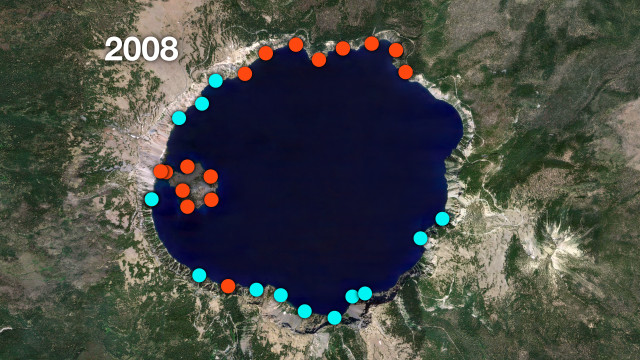Struggling Crater Lake Mazama Newts
0No good deed goes unpunished, as the saying goes. And despite the good intentions that Crater Lake National Park managers had back in 1915, stocking crayfish in the lake is an excellent example of well-intentioned folks having their plans backfire.
Following the stocking of fish (trout, salmon, other gamefish) in the lake to attract fishermen more than 100 years ago, park managers stocked crayfish there to provide the fish with a food source. That has turned out to be worse than stocking the non-native fish in the first place, researchers from the park have found.
While stocking the fish drastically upended the food chain in Crater Lake, chiefly by forcing the endemic Mazama newt out of its top-predator spot, adding the crayfish has threatened the newts’ survival entirely.

Crater Lake, Oregon. (Credit: Flickr User Jonathan Miske via Creative Commons 2.0)
Scientists working at the national park have been documenting the impacts of the crayfish to Crater Lake and the rare newts within the past decade.
The effects that the crayfish have had are wide-ranging. For one, park managers have found that a lot of different creatures, including the Mazama newts, just don’t hang around if crayfish are present. These include the likes of snails, caddisflies and mayflies.
A good example of this is the distribution changes that park managers have observed between the years of 2008 and 2014. In just six years, Mazama newts have gone from living in more than half of Crater Lake’s shallow areas to inhabiting less than a quarter of them.

In 2008, scientists found newts (blue dots) occupied about half of Crater Lake’s shoreline while crayfish (red dots) had most of the rest. (Credit: Madeleine Pisaneschi / KCTS9 Seattle, Oregon Public Broadcasting)

By 2014, the crayfish (red dots) had taken over 75 percent of Crater Lake’s shallows, displacing the Mazama newts (blue dots). (Credit: Madeleine Pisaneschi / KCTS9 Seattle, Oregon Public Broadcasting)
But not only does the presence of crayfish serve as a strong deterrent to other species, the crab-like creatures back up their reputation with their predatory abilities. They eat pretty much everything, including algae, plants, aquatic insects, worms and snails. The crayfish eat amphibians, tiny fish and even each other if they have to. Dead or alive, a meal is a meal for them.
These ruthless advantages have led the scientists studying the crayfish to call them the perfect invaders. And they are further buoyed by the Mazama newts’ evolutionary loss (from having no competition for so long) of its main weapon: a neurotoxin strong enough to kill most creatures.
The crayfish have benefited by rising populations throughout the lake, scientists say. In addition to giving them strength in numbers, the surge has also forced them to branch out and find new shallows to live in. Warmer water temperatures in Crater Lake, which have gone up nearly 3 degrees in the past 10 years, may also be aiding the bottom-feeders by making them more active and helping their breeding cycles.

A mazama newt. (Credit: National Park Service)
To combat the crayfish, scientists with the park as well as nearby universities are throwing a number of things their way. These include routine trawls for the crayfish, in addition to emerging methods to keep them away from Mazama newt populations, like fences. The researchers are also working to better track crayfish as they move around the lake by injecting them with a blue polymer that hardens under their shells to stick with them for life.
But so far the measures aren’t making much of a dent. After recent expeditions to remove thousands of crayfish from Crater Lake, their populations were found to still be growing. Putting up fences may not be a feasible option either, as scientists are concerned that the structures could damage the pristine lake’s aesthetic appeal or other habitats.
Should Crater Lake National Park have been stocked with fish or crayfish decades ago? What methods might work to stem the rise of crayfish there? Please leave a comment and share your thoughts.













